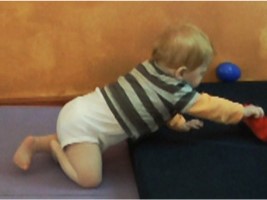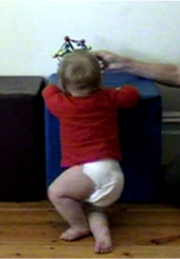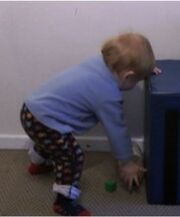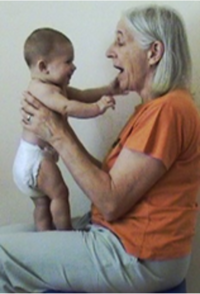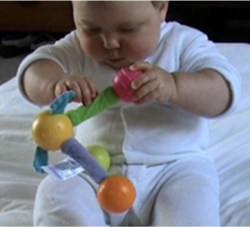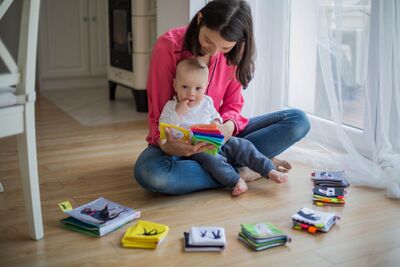Best Practice in Developmental Skills Training in Early Intervention: Difference between revisions
m (wording) |
No edit summary |
||
| (47 intermediate revisions by 7 users not shown) | |||
| Line 1: | Line 1: | ||
<div class="editorbox"> | <div class="editorbox"> '''Original Editor '''- [[User:Robin Tacchetti|Robin Tacchetti]] based on the course by [https://members.physio-pedia.com/course_tutor/pam-versfeld/ Pam Versfeld]<br> | ||
'''Original Editor '''- [[User: | '''Top Contributors''' - {{Special:Contributors/{{FULLPAGENAME}}}}</div> | ||
'''Top Contributors''' - {{Special:Contributors/{{FULLPAGENAME}}}} | |||
</div> | |||
=== Early Intervention === | === Early Intervention === | ||
Early intervention | [[Early Intervention and the Importance of Early Identification of Cerebral Palsy|Early intervention]] programmes provide education and therapy resources to families of children with developmental delays aged three years and under. Services included in early intervention programmes might include speech therapy, occupational therapy, physiotherapy, vision, nursing care, hearing and assistive technology. Evaluations are typically performed in a natural environment for the child such as the home or daycare.<ref name=":0">Tomasello NM, Manning AR, Dulmus CN. [https://www.tandfonline.com/doi/full/10.1080/10522150903503010 Family-centered early intervention for infants and toddlers with disabilities.] Journal of Family Social Work. 2010 Mar 24;13(2):163-72.</ref> Please watch the video below from the Allen County Board of Developmental Disabilities to quickly learn more about early intervention. | ||
{{#ev:youtube|VH2IRTqWXew}} | |||
==== Family Centred Care ==== | ==== Family Centred Care ==== | ||
Early intervention services are geared | [[File:Babymovement B4.jpg|thumb|'''Figure.1''' Infant on all Fours]] | ||
[[Early Intervention in Cerebral Palsy|Early intervention]] services are geared towards empowering families to be the decision-makers for their child’s goals and intervention. In this [[Family Centered Intervention and Early Diagnosis|family centred approach]], the therapist works as a coach and collaborator with the family, rather than as a knowledge expert who makes all the decisions.<ref name=":0" /> Initially, the family and therapist will discuss the family’s circumstance's and any difficulties they may be experiencing. Understanding their concerns and hopes will help shape goals and specific selection of intervention tasks. During the assessment, the therapist will observe the child performing specific tasks to determine what they are capable of, their strengths, how much assistance is required, what is constraining the task and what adaptations can be made to allow the child to succeed. The therapist and family then together decide on ways to practise the tasks within the child’s daily routine. Providing home exercise programmes via video or written instruction can be helpful reminders for families.<ref name=":3">Morgan C, Novak I, Dale RC, Guzzetta A, Badawi N. [https://bmcneurol.biomedcentral.com/articles/10.1186/s12883-014-0203-2 GAME (Goals-Activity-Motor Enrichment): protocol of a single-blind randomised controlled trial of motor training, parent education and environmental enrichment for infants at high risk of cerebral palsy.] BMC neurology. 2014 Dec;14(1):1-9.</ref> | |||
=== | === Goals === | ||
[[File: Babystanding D2.png|thumb|alt=|259x259px|'''Figure.2''' Infant Pulling to Stand]] | |||
Dalmau et al.<ref>Dalmau M, Balcells-Balcells A, Giné C, Cañadas M, Casas O, Salat Y, Farré V, Calaf N. [https://pdfs.semanticscholar.org/e0e5/89f98828ff03f1b6fad2293624937abc44b8.pdf How to implement the family-centered model in early intervention]. Anales de psicología. 2017;33(3):641-51.</ref> recommend the following when setting up goals for the child: | |||
# "They are functional and needed for the child and family to be able to participate in the activities that are important for them. The goals are always established on the basis of what the family considers to be necessary and functional for them, not on the basis of what the professional thinks or believes to be useful or significant in their lives." | |||
# "They reflect real situations of daily life and routines of the families, such as having meals, baths, going to the park, etc. Often, the goals set up by developmental areas are neither contextualized nor represent situations of daily life." | |||
# "They describe the participation of the child and/or family in routines, which means that in the writing it is the child or family that are the “actors”, not the professionals." | |||
# "Their writing has to be free of jargon, using daily routines and activities." | |||
# "They always emphasize positive actions, identifying what the child or family can do, rather than what they cannot do." | |||
# "Active voice is preferred to passive voice; expressions that imply involvement and active participation of the child/family" | |||
=== GAME Intervention === | |||
One early intervention approach used for infants at risk for Cerebral Palsy (CP) is called GAME: Goal based (G) activity (A) with intensive motor training (M) in an enriched environment (E).<ref>Gmmash AS, Effgen SK. [https://journals.lww.com/pedpt/Fulltext/2019/07000/Early_Intervention_Therapy_Services_for_Infants.4.aspx Early intervention therapy services for infants with or at risk for cerebral palsy. Pediatric Physical Therapy]. 2019 Jul 1;31(3):242-9.</ref> This approach has three components: | |||
# Goal-oriented intensive [[Motor Learning - Back to the Basics|motor training]] | |||
# Parent Education | |||
# Strategies to enrich the child’s motor learning environment | |||
<br> | |||
Visits are usually weekly at first, but the frequency changes according to the family’s preference, availability and resources. A GAME intervention session usually lasts between 60-90 minutes.<ref name=":3" /> A recent systematic literature review showed that GAME interventions for infants prior to 5 months old are superior to standard care.<ref name=":4">Damiano DL, Longo E. Early intervention evidence for infants with or at risk for cerebral palsy: an overview of systematic reviews. Developmental Medicine & Child Neurology. 2021 Apr 6.</ref> | |||
3. | ==== Goal Oriented Intensive MotorTraining ==== | ||
[[File:Taskspecificbaby 3.jpg|thumb|alt=|217x217px|'''Figure.3''' Infant Picking Toy from Floor]] | |||
Goals created by the therapist and family are the focus during therapy sessions and for the home programme. Parent-identified goal areas are targeted for practice during the therapy session and and in a home program (HP). <ref name=":3" /> | |||
During practice of motor tasks, the therapist or parent scaffolds all motor tasks, so that the infant could always actively complete at least a part of the task. As performance improves, the challenge is increased by altering the task or environment to a new and appropriate level of difficulty.<ref name=":3" /> | |||
Manual assistance is provided by the therapist and parent only when necessary for safety or to give the infant the “idea” of the movement. “Manual assistance is reduced or withdrawn as soon as the infant demonstrates self-initiated progress with the task; ensuring self-generated motor activity is the focus of all practice. Once a motor skill is learned, variability of practice is introduced to increase the complexity” and generalisation of the skill.<ref name=":3" /> | |||
The task goal materialises based on the interplay of the task requirement (task demand) (T), the individual child (I) and the environment (E) or TIE principle. When analysing the child’s performance, all three components of the TIE principle must be considered.<ref name=":1">Versfeld, P. Best Practice In Developmental Skills Training in Early Intervention. Course. Plus. 2021</ref> Task-specific training should incorporate successful trials as it motivates the child towards continued repetition. Optimal outcomes are obtained through repetition and intensive practice.<ref name=":2">Morgan C, Fetters L, Adde L, Badawi N, Bancale A, Boyd RN, Chorna O, Cioni G, Damiano DL, Darrah J, de Vries LS. Early Intervention for Children Aged 0 to 2 Years With or at High Risk of Cerebral Palsy: International Clinical Practice Guideline Based on Systematic Reviews. JAMA paediatrics. 2021 May 17.</ref> Goals and tasks may be adapted to achieve success with the whole task or parts of the task. Once the infant is successful in a specified task, the motor skill is challenged by building on the previously learned skill. Activities accentuate minimal manual guidance with the ability to withdraw assistance once the child is able to successfully demonstrate the specified movement or sequence.<ref name=":3" /> | |||
=== | ===== Early Weight Bearing ===== | ||
[[File:WeightBearingbaby 2.png|thumb|294x294px|'''Figure.4''' Infant and Therapist Interacting]] | |||
Early [[weight bearing]] and sit-to-stand from a parent's lap is routinely practiced in the GAME approach even if they are not specified goals. Research shows that functional weight-bearing can provide strength training and improve [[Motor Learning - Back to the Basics|motor control]] in older children and adults with brain injuries.<ref name=":3" /> Upright mobility can be enhanced by the early activation of muscles in the leg with the facilitation of concentric and eccentric exercises. For children with [[Cerebral Palsy Introduction|Cerebral Palsy]], routine standing practice could assist with impairments such as weakness and selective motor control.<ref>Chaovalit S, Dodd KJ, Taylor NF. [https://onlinelibrary.wiley.com/doi/epdf/10.1111/dmcn.14979 Sit‐to‐stand training for self‐care and mobility in children with cerebral palsy: a randomized controlled trial.] Developmental Medicine & Child Neurology. 2021 Dec;63(12):1476-82.</ref><ref name=":3" /> | |||
===== Reaching and Grasping ===== | |||
[[File:BabyReaching 1.png|thumb|alt=|left|250x250px|'''Figure.5''' Infant playing with toy]] | |||
For infants who are at risk for developmental delay, grasping and reaching a variety of objects are standard motor training tasks within the GAME approach. | |||
Providing many opportunities to use hands for object manipulation through experience is critical for optimising hand function.<ref name=":3" /> In cases where asymmetrical hand function is present, modified [[Constraint Induced Movement Therapy|constraint induced]] movement therapy (CIMT) and/or bimanual training can be used.<ref name=":4" /><ref name=":2" /> | |||
Research shows that [[Baby-CIMT (Constraint Induced Movement Therapy for infants)|CMIT]] during the first year of life has a positive influence on the hand function of infants who have unilateral CP.<ref>Eliasson AC, Nordstrand L, Ek L, Lennartsson F, Sjöstrand L, Tedroff K, Krumlinde-Sundholm L. [https://www.researchgate.net/publication/321336048_The_effectiveness_of_Baby-CIMT_in_infants_younger_than_12_months_with_clinical_signs_of_unilateral-cerebral_palsy_an_explorative_study_with_randomized_design The effectiveness of Baby-CIMT in infants younger than 12 months with clinical signs of unilateral-cerebral palsy; an explorative study with randomized design.] Research in developmental disabilities. 2018 Jan 1;72:191-201.</ref><ref>Hoare BJ, Wallen MA, Thorley MN, Jackman ML, Carey LM, Imms C. [https://www.ncbi.nlm.nih.gov/pmc/articles/PMC6442500/pdf/CD004149.pdf Constraint-induced movement therapy in children with unilateral cerebral palsy.] Cochrane Database Syst Rev. 2019 Apr 1;4(4):CD004149. </ref> | |||
===== Home Practice ===== | |||
The GAME intervention emphasises the importance of developing a home programme that provides the infant with the opportunity for independent play and plays activities with the family. Written instructions with pictures are provided that relate to the family's goals, as well as weight-bearing and reach and grasp activities. Home programmes can be updated as goals are reached. Practice schedules should also be designed based on family time constraints and available resources.<ref name=":3" /> | |||
==== Parental Involvement and Education ==== | |||
Parents play an active role in selecting goals and carrying out a home program. Parents are provided with the knowledge and skills to promote and support their baby's self-initiated and generated actions, exploration and engagement with motor tasks. <ref name=":3" /> | |||
Parent education as described by Morgan et al.:<ref name=":3" /><blockquote>“Parents are coached to identify their child’s voluntary attempts to move and self-regulate, plus understand the usual trajectory of emergent motor skills and how to stimulate progress. | |||
Parents are trained in simple motor task analysis and coached in appropriate strategies to enhance their child’s development both at a specific goal level and in general early learning and development principles. | |||
Parents are taught to optimise the best use of their infants’ awake time and the naturally occurring opportunities for learning. Learning optimisation included both parent-directed and structured practice of desired motor tasks, where the parent role was integral to the child’s learning (e.g. creating repetitions) and constructing opportunities for independent play (e.g. playing alone with motor enriching toys set up for the child). | |||
Parents are encouraged to both observe the therapist eliciting a motor behaviour from the baby and to attempt it themselves. Specific feedback was given to parents to enable them to tease out why some attempts were successful for the baby and others weren’t. | |||
As new motor skills emerged parents are coached in strategies to increase the challenge of the task; for example remove support or introduce a more complex toy. | |||
The importance of allowing trial and error during practice is discussed and parents are encouraged to devise their own activities to enhance goal attainment.” <ref name=":3" /></blockquote> | |||
==== | ==== Environmental Enrichment ==== | ||
[[File:Motherbabyplaying.jpg|thumb|400x400px|'''Figure.6''' Parent reading to infant]]Providing an enriched environment that encourages active exploration and play within the family’s home is the third aspect of the GAME intervention. Toys or equipment are used that the family already owns with a careful selection of what is needed to match the child’s abilities and interests.<ref name=":3" /> Morgan et al.<ref name=":3" /> state that the whole environment should be taken into account, which may include: | |||
* "evidence-based early learning stimulation and role modelling to enhance cognitive and language development (e.g. reading books to children, limiting passive television watching); | |||
* optimising sleep hygiene; | * optimising sleep hygiene; | ||
* feeding interventions (e.g. anti-reflux medications) to ensure adequate caloric nutrition and pain-free backdrops for learning. | * feeding interventions (e.g. anti-reflux medications) to ensure adequate caloric nutrition and pain-free backdrops for learning." | ||
<br> | |||
Extended family members are encouraged to engage in social interaction with the child, as well as to participate in therapy sessions as this will help to enhance family knowledge, and promote acceptance and wellbeing. As mentioned, GAME therapists initially visit families weekly, before altering the frequency based on the family’s availability, resources and preference.<ref name=":3" /> | |||
==Resources== | ==Resources== | ||
* | *[[Cerebral Palsy Introduction]] | ||
* | *[[Family Centred Intervention and Early Diagnosis]] | ||
*[[Gross Motor Function Classification System - Expanded and Revised (GMFCS-ER)]] | |||
*[[Early Intervention in Cerebral Palsy]] | |||
==References== | ==References== | ||
<references /> | |||
[[Category:Course Pages]] | |||
[[Category:ReLAB-HS Course Page]] | |||
[[Category:Cerebral Palsy]] | |||
[[Category:Paediatrics]] | |||
[[Category:Paediatrics - Interventions]] | |||
[[Category:Paediatrics - Guidelines]] | |||
[[Category:Rehabilitation]] | |||
Latest revision as of 20:44, 18 January 2023
Top Contributors - Robin Tacchetti, Robin Leigh Tacchetti, Tarina van der Stockt, Kim Jackson, Ewa Jaraczewska, Naomi O'Reilly, Jess Bell and Olajumoke Ogunleye
Early Intervention[edit | edit source]
Early intervention programmes provide education and therapy resources to families of children with developmental delays aged three years and under. Services included in early intervention programmes might include speech therapy, occupational therapy, physiotherapy, vision, nursing care, hearing and assistive technology. Evaluations are typically performed in a natural environment for the child such as the home or daycare.[1] Please watch the video below from the Allen County Board of Developmental Disabilities to quickly learn more about early intervention.
Family Centred Care[edit | edit source]
Early intervention services are geared towards empowering families to be the decision-makers for their child’s goals and intervention. In this family centred approach, the therapist works as a coach and collaborator with the family, rather than as a knowledge expert who makes all the decisions.[1] Initially, the family and therapist will discuss the family’s circumstance's and any difficulties they may be experiencing. Understanding their concerns and hopes will help shape goals and specific selection of intervention tasks. During the assessment, the therapist will observe the child performing specific tasks to determine what they are capable of, their strengths, how much assistance is required, what is constraining the task and what adaptations can be made to allow the child to succeed. The therapist and family then together decide on ways to practise the tasks within the child’s daily routine. Providing home exercise programmes via video or written instruction can be helpful reminders for families.[2]
Goals[edit | edit source]
Dalmau et al.[3] recommend the following when setting up goals for the child:
- "They are functional and needed for the child and family to be able to participate in the activities that are important for them. The goals are always established on the basis of what the family considers to be necessary and functional for them, not on the basis of what the professional thinks or believes to be useful or significant in their lives."
- "They reflect real situations of daily life and routines of the families, such as having meals, baths, going to the park, etc. Often, the goals set up by developmental areas are neither contextualized nor represent situations of daily life."
- "They describe the participation of the child and/or family in routines, which means that in the writing it is the child or family that are the “actors”, not the professionals."
- "Their writing has to be free of jargon, using daily routines and activities."
- "They always emphasize positive actions, identifying what the child or family can do, rather than what they cannot do."
- "Active voice is preferred to passive voice; expressions that imply involvement and active participation of the child/family"
GAME Intervention[edit | edit source]
One early intervention approach used for infants at risk for Cerebral Palsy (CP) is called GAME: Goal based (G) activity (A) with intensive motor training (M) in an enriched environment (E).[4] This approach has three components:
- Goal-oriented intensive motor training
- Parent Education
- Strategies to enrich the child’s motor learning environment
Visits are usually weekly at first, but the frequency changes according to the family’s preference, availability and resources. A GAME intervention session usually lasts between 60-90 minutes.[2] A recent systematic literature review showed that GAME interventions for infants prior to 5 months old are superior to standard care.[5]
Goal Oriented Intensive MotorTraining[edit | edit source]
Goals created by the therapist and family are the focus during therapy sessions and for the home programme. Parent-identified goal areas are targeted for practice during the therapy session and and in a home program (HP). [2]
During practice of motor tasks, the therapist or parent scaffolds all motor tasks, so that the infant could always actively complete at least a part of the task. As performance improves, the challenge is increased by altering the task or environment to a new and appropriate level of difficulty.[2]
Manual assistance is provided by the therapist and parent only when necessary for safety or to give the infant the “idea” of the movement. “Manual assistance is reduced or withdrawn as soon as the infant demonstrates self-initiated progress with the task; ensuring self-generated motor activity is the focus of all practice. Once a motor skill is learned, variability of practice is introduced to increase the complexity” and generalisation of the skill.[2]
The task goal materialises based on the interplay of the task requirement (task demand) (T), the individual child (I) and the environment (E) or TIE principle. When analysing the child’s performance, all three components of the TIE principle must be considered.[6] Task-specific training should incorporate successful trials as it motivates the child towards continued repetition. Optimal outcomes are obtained through repetition and intensive practice.[7] Goals and tasks may be adapted to achieve success with the whole task or parts of the task. Once the infant is successful in a specified task, the motor skill is challenged by building on the previously learned skill. Activities accentuate minimal manual guidance with the ability to withdraw assistance once the child is able to successfully demonstrate the specified movement or sequence.[2]
Early Weight Bearing[edit | edit source]
Early weight bearing and sit-to-stand from a parent's lap is routinely practiced in the GAME approach even if they are not specified goals. Research shows that functional weight-bearing can provide strength training and improve motor control in older children and adults with brain injuries.[2] Upright mobility can be enhanced by the early activation of muscles in the leg with the facilitation of concentric and eccentric exercises. For children with Cerebral Palsy, routine standing practice could assist with impairments such as weakness and selective motor control.[8][2]
Reaching and Grasping[edit | edit source]
For infants who are at risk for developmental delay, grasping and reaching a variety of objects are standard motor training tasks within the GAME approach.
Providing many opportunities to use hands for object manipulation through experience is critical for optimising hand function.[2] In cases where asymmetrical hand function is present, modified constraint induced movement therapy (CIMT) and/or bimanual training can be used.[5][7]
Research shows that CMIT during the first year of life has a positive influence on the hand function of infants who have unilateral CP.[9][10]
Home Practice[edit | edit source]
The GAME intervention emphasises the importance of developing a home programme that provides the infant with the opportunity for independent play and plays activities with the family. Written instructions with pictures are provided that relate to the family's goals, as well as weight-bearing and reach and grasp activities. Home programmes can be updated as goals are reached. Practice schedules should also be designed based on family time constraints and available resources.[2]
Parental Involvement and Education[edit | edit source]
Parents play an active role in selecting goals and carrying out a home program. Parents are provided with the knowledge and skills to promote and support their baby's self-initiated and generated actions, exploration and engagement with motor tasks. [2]
Parent education as described by Morgan et al.:[2]
“Parents are coached to identify their child’s voluntary attempts to move and self-regulate, plus understand the usual trajectory of emergent motor skills and how to stimulate progress.
Parents are trained in simple motor task analysis and coached in appropriate strategies to enhance their child’s development both at a specific goal level and in general early learning and development principles.
Parents are taught to optimise the best use of their infants’ awake time and the naturally occurring opportunities for learning. Learning optimisation included both parent-directed and structured practice of desired motor tasks, where the parent role was integral to the child’s learning (e.g. creating repetitions) and constructing opportunities for independent play (e.g. playing alone with motor enriching toys set up for the child).
Parents are encouraged to both observe the therapist eliciting a motor behaviour from the baby and to attempt it themselves. Specific feedback was given to parents to enable them to tease out why some attempts were successful for the baby and others weren’t.
As new motor skills emerged parents are coached in strategies to increase the challenge of the task; for example remove support or introduce a more complex toy.
The importance of allowing trial and error during practice is discussed and parents are encouraged to devise their own activities to enhance goal attainment.” [2]
Environmental Enrichment[edit | edit source]
Providing an enriched environment that encourages active exploration and play within the family’s home is the third aspect of the GAME intervention. Toys or equipment are used that the family already owns with a careful selection of what is needed to match the child’s abilities and interests.[2] Morgan et al.[2] state that the whole environment should be taken into account, which may include:
- "evidence-based early learning stimulation and role modelling to enhance cognitive and language development (e.g. reading books to children, limiting passive television watching);
- optimising sleep hygiene;
- feeding interventions (e.g. anti-reflux medications) to ensure adequate caloric nutrition and pain-free backdrops for learning."
Extended family members are encouraged to engage in social interaction with the child, as well as to participate in therapy sessions as this will help to enhance family knowledge, and promote acceptance and wellbeing. As mentioned, GAME therapists initially visit families weekly, before altering the frequency based on the family’s availability, resources and preference.[2]
Resources[edit | edit source]
- Cerebral Palsy Introduction
- Family Centred Intervention and Early Diagnosis
- Gross Motor Function Classification System - Expanded and Revised (GMFCS-ER)
- Early Intervention in Cerebral Palsy
References[edit | edit source]
- ↑ 1.0 1.1 Tomasello NM, Manning AR, Dulmus CN. Family-centered early intervention for infants and toddlers with disabilities. Journal of Family Social Work. 2010 Mar 24;13(2):163-72.
- ↑ 2.00 2.01 2.02 2.03 2.04 2.05 2.06 2.07 2.08 2.09 2.10 2.11 2.12 2.13 2.14 2.15 Morgan C, Novak I, Dale RC, Guzzetta A, Badawi N. GAME (Goals-Activity-Motor Enrichment): protocol of a single-blind randomised controlled trial of motor training, parent education and environmental enrichment for infants at high risk of cerebral palsy. BMC neurology. 2014 Dec;14(1):1-9.
- ↑ Dalmau M, Balcells-Balcells A, Giné C, Cañadas M, Casas O, Salat Y, Farré V, Calaf N. How to implement the family-centered model in early intervention. Anales de psicología. 2017;33(3):641-51.
- ↑ Gmmash AS, Effgen SK. Early intervention therapy services for infants with or at risk for cerebral palsy. Pediatric Physical Therapy. 2019 Jul 1;31(3):242-9.
- ↑ 5.0 5.1 Damiano DL, Longo E. Early intervention evidence for infants with or at risk for cerebral palsy: an overview of systematic reviews. Developmental Medicine & Child Neurology. 2021 Apr 6.
- ↑ Versfeld, P. Best Practice In Developmental Skills Training in Early Intervention. Course. Plus. 2021
- ↑ 7.0 7.1 Morgan C, Fetters L, Adde L, Badawi N, Bancale A, Boyd RN, Chorna O, Cioni G, Damiano DL, Darrah J, de Vries LS. Early Intervention for Children Aged 0 to 2 Years With or at High Risk of Cerebral Palsy: International Clinical Practice Guideline Based on Systematic Reviews. JAMA paediatrics. 2021 May 17.
- ↑ Chaovalit S, Dodd KJ, Taylor NF. Sit‐to‐stand training for self‐care and mobility in children with cerebral palsy: a randomized controlled trial. Developmental Medicine & Child Neurology. 2021 Dec;63(12):1476-82.
- ↑ Eliasson AC, Nordstrand L, Ek L, Lennartsson F, Sjöstrand L, Tedroff K, Krumlinde-Sundholm L. The effectiveness of Baby-CIMT in infants younger than 12 months with clinical signs of unilateral-cerebral palsy; an explorative study with randomized design. Research in developmental disabilities. 2018 Jan 1;72:191-201.
- ↑ Hoare BJ, Wallen MA, Thorley MN, Jackman ML, Carey LM, Imms C. Constraint-induced movement therapy in children with unilateral cerebral palsy. Cochrane Database Syst Rev. 2019 Apr 1;4(4):CD004149.
